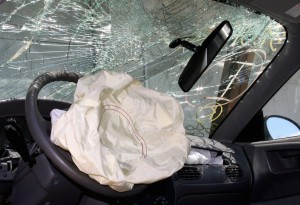
17-year-old Huma Hanif was killed when the Takata airbag in her Honda malfunctioned. Courtesy: WHOU.
The number of vehicles facing recall due to potentially defective Takata airbags continues to grow – as does the possible bill for replacing the faulty safety systems.
So far, about 24 million vehicles sold in the U.S. have been recalled as a result of the problem which has been linked to 11 deaths, including a 17-year Texas girl killed in a March 31 crash. But an analysis by the National Highway Traffic Safety Administration warns that as many as 85 million additional airbag inflators might be defective.
Because many vehicles use multiple Takata inflators, the exact number of cars, trucks and crossovers that would be affected is not clear. But it is likely to be significantly larger than the number of vehicles already affected by the current Takata recall.
Also unclear is who would be responsible for paying for a greatly expanded airbag recall. By some published estimates, industry analysts suggest the price tag could surge to $3.5 billion. It is widely considered likely that such a figure would crush Takata, the Japanese supplier already losing a number of key customers, including Honda, traditionally its biggest client, in recent months.
The company reportedly is already searching for new financial backing. It remains unclear who would step in, especially if that involved the assumption of such significant liabilities at a time when Takata’s customer base is shrinking.
The problem centers around airbag inflators – the explosive devices triggered in a crash. They’re designed to create a blast of hot gases that force an airbag to burst out of hiding to provide a cushion meant to reduce injuries and fatalities. But hundreds of Takata inflators have malfunctioned, over-inflating with enough force to send plastic and metal shrapnel spewing into the passenger compartment.
Last month, such a scenario played out in a 2002 Honda driven by high-school senior Huma Hanif in Richmond, Texas. According to Fort Bend County Sheriff Troy Nehls, the 17-year-old’s key rammed another vehicle at just 15 mph.
“We see crashes like this each and every day,” Nehls said. “She should have walked away from this with very few injuries.”
(For more on the latest fatal crash, Click Here.)
Similar crashes have resulted in at least nine additional deaths in the U.S. and another overseas.
The precise cause of the problem has been a matter of debate. Initially linked to a manufacturing defect at two of Takata’s North American factories, the supplier and NHTSA early on thought the problem was triggered by excess humidity when vehicles were operated in regions like Southern Florida. But a study undertaken by a consortium of automakers and released last month expanded the list of probably causes. It warned that the basic chemical used to power Takata’s inflators may be the real issue.
Over time, it now appears, explosive ammonium nitrate can break down and misfire no matter where the vehicles are operated.
(GM minimizes impact as it settles fourth bellwether ignition switch recall case. Click Here for the latest.)
Late last year NHTSA fined Takata for its handling of the airbag crisis – the supplier long resisting an expanded recall. It also warned the company it would face additional fines if it didn’t improve its safety procedures. Meanwhile, Takata was given until 2019 to prove the remaining airbags using ammonium nitrate aren’t also at risk of failure.
But with growing pressure from Congress and safety advocates, as well as from within NHTSA itself, the agency may choose not to wait that long. The new accounting suggests the federal agency may order a further recall in the near future.
While many safety advocates favor that move, some have warned the move could create a potentially serious problem of its own, however.
So far, 14 makers using Takata airbags have ordered recalls, but most have been struggling to come up with enough replacement parts to handle the vehicles already covered by mandatory service orders. Toyota and BMW, among others, have even contracted other airbag suppliers to provide replacements. But the slow process is one reason that only about 28% of the vehicles hit with Takata recalls to date have actually been repaired.
How long it would stretch out the process to add tens of millions more vehicles to the list is uncertain. Some advocates want to focus on the vehicles most at risk and only when those repairs are completed would they want the Takata recall to be further expanded.
(How can NHTSA improve the recall response rate? Click Here for the story.)


